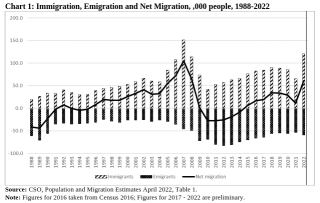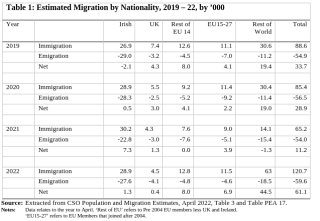Planning Ahead for Ireland's Demographic Shift

The preliminary results from Census 2022 record a population in April of 2022 of 5,123,536 persons. This is an increase of 361,671 people (7.6 per cent) from Census 2016 and the highest population recorded since 1841. This growing population is also becoming more urbanised and increasingly well educated, particularly women. Fertility rates are declining and the age at which women are having their first child has increased from 24.9 in 1980 to 31 in 2017. Life expectancy, on the other hand, has increased with male life expectancy reaching 79.3 years in 2015 and female life expectancy reaching 83.3 years that year. [1]
This reduction in fertility levels and increased life expectancy means that Ireland’s population, while still relatively young, is getting older. The average age of the population is now 37.4, an increase of 6.3 years since 1981. The population is also becoming more diverse, with an estimated 3.6 per cent of the population (183,500 people) with a stated nationality as being from outside of the EU.
Emigration and Immigration
Net migration into Ireland was positive in April 2022, continuing a pattern which has been in place since 2015. This means that more people have entered the country than are leaving it. Immigration has only been higher once in the past 30 years with the numbers entering the country the highest since 2008, a large number of these have arrived as refugees from Ukraine. Analysing migration trends over the past 30 years, we see a relatively high rate of emigration in 1988 and 1989, at a time of recession, which decreased slowly over the next 10 years peaking again in 2012 whereas immigration figures rise slowly from 1990, peaking in 2007. (Chart 1)

The recent years of decreasing emigration and increasing immigration indicated a renewed confidence in Ireland’s economic prospects, however given the issues with housing, health and the cost of living, explored elsewhere in this book, we will need to continue to monitor migration trends. The high levels of immigration in 2022 have highlighted the lack of school spaces providing suitable language and learning supports, the shortage of G.P.s, the severe shortage of affordable, stable accommodation, the importance of providing supports to communities and the stark differences in the response to refugees from Ukraine compared to elsewhere.
In terms of nationality, less than one in four (24 per cent) of total immigrants to Ireland in 2022 had a nationality from within the EU (excluding Ireland and the UK), less than 1 per cent were UK nationals and 72 per cent had a nationality from within the rest of the world (Table 1). [2]

Ireland as a multicultural society
Integration is defined in current Irish policy as the ‘ability to participate to the extent that a person needs and wishes in all of the major components of society without having to relinquish his or her own cultural identity’. For the almost 13 per cent of the population who are non-Irish nationals, achieving real integration requires concerted policy responses aimed at supporting education, job activation, tackling hate speech and racism and supporting cultural awareness.
According to Census 2016, there was a total of 535,475 non-Irish nationals – representing 200 different nations - living in Ireland on Census night. The main nationalities were Polish (23 per cent) and UK (19 per cent). Other nationalities with over 10,000 residents included USA, Brazil, France, Germany, India, Latvia, Lithuania, Romania and Spain. Non Irish nationals have a very different age profile to the rest of the population with half aged between 25 and 42 compared with a quarter of the Irish population. There are proportionately fewer children under 14 (12.3 per cent versus 22.5 per cent), and older people (4 per cent versus 13 per cent) among non-Irish nationals. The unemployment rate among non-Irish nationals was 15.4 per cent, compared with a rate of 12.6 per cent among the Irish population.
Census 2016 also asked people to identify their ethnicity and cultural background. 681,016 people identify themselves as other than “White Irish”, of whom 234,289 identify as Black, Asian or other people of colour.
At the time of writing, 74,458 Ukrainian refugees, primarily women and children, have arrived in Ireland with thousands more still expected.[3] The EU is granting “temporary protection" status, which means they can live, settle and work in the EU for a period of time. This is to be welcomed; however, it is in stark contrast to the treatment of refugees fleeing other war-torn territories. Our approach needs to consistent, placing human rights at the centre of International Protection policies.
The infrastructure, services and policies that a country develops and implements are determined in large part by the make-up of its population. Every person should have a right to have a say in how and where infrastructure and services are delivered, and what policies are implemented to shape their communities. Local and national Government policies affect every one of us, and every one of us should have our say. Part of the ‘Good Governance’ pillar in Social Justice Ireland’s Policy Framework for a new Social Contract, requires the promotion of deliberative democracy, as well as new criteria in policy evaluation and the continued development of a social dialogue process involving all sectors of society. This is a core tenet of living in a democracy. At a time when the very fabric of democracy is increasingly under threat across the globe, this is something we must strive to protect.
We must also ensure that we plan ahead for these changes to our demographic, ensuring that housing, education, healthcare, work and transport take account of our ageing population. Also forecasting migration appropriately would support Government to plan for the future with greater accuracy. A variety of methods currently exist to forecast migration flows, which would allow for more considered approaches to welcoming those arriving to Ireland, regardless of their reasons for doing so.